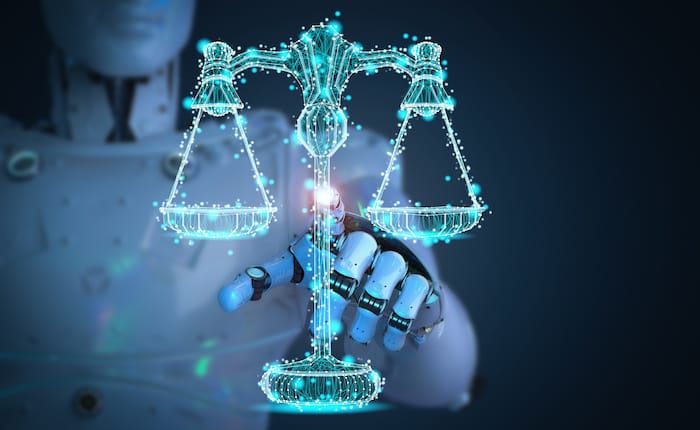Jake Fletcher-Stega, a recent University of Liverpool law grad, explores the potential for technology to enhance legal services

Utilising advancements like artificial intelligence (AI) and chatbots in the UK can greatly boost efficiency and accessibility in the legal system. Legal tech has the potential to substantially elevate the quality of legal services, prioritising client outcomes over traditional methods, which is crucial for advancing the legal field.
Inspired by Richard Susskind’s work (a leading legal tech advisor, author and academic), this article seeks to demonstrate AI’s potential to spearhead advancements in the legal field and provide solutions to the issue of court backlogs currently plaguing the UK system.
The problem: the overloaded UK court system
Despite our faith in the right to access to justice as a cornerstone of the British legal framework, the reality is that this is far less certain than might appear. Briefly put, access to justice is the ability of individuals to assert and safeguard their legal rights and responsibilities. In 2012, the Legal Aid, Sentencing and Punishment of Offenders Act (LASPO) significantly reduced funding for the UK justice system, resulting in a current backlog of approximately 60,000 cases and leaving many unable to afford representation.
If we are to fix this ongoing crisis, a fresh, unique, and revolutionary solution is required. I suggest that adopting an innovative approach, such as the use of legal technology, could significantly improve access to justice.
The solution: legal tech
To echo the view of leading academic Susskind, the legal delivery service is outdated and overly resistant to technological advancements. He asserts that the utilisation of artificial intelligence, automation, and big data has the potential to revolutionise the methods through which legal services can be provided and executed. I must reiterate, it isn’t beneficial that our legal sector is overly conservative and technophobic. Other professions have moved forward with technology, but lawyers haven’t.
Lawyers are behind the curve when compared to other sectors such as finance and medicine who are now utilising technology such MicrosoftInnerEye. Law isn’t significantly different from medical and financial advice. Not different enough to deny the value of innovating our legal services.
The belief that the legal field cannot innovate in the same way as other industries due to its epistemological nature is a common misconception. Many argue that AI will never fully replicate human reasoning, analysis, and problem-solving abilities, leading to the assumption that it cannot pose a threat to human professionals whose job primarily involves ‘reasoning’. However, this perspective is flawed.
While AI may not operate identically to humans, its capability to perform similar tasks and achieve comparable outcomes cannot be underestimated. Instead of fixating on the differences in the way tasks are accomplished, we should shift our focus to the end result.
Embracing AI/Legal Tech and its potential to augment legal services can lead to more efficient, accessible, and effective outcomes for clients, without entirely replacing the valuable expertise and experience that human professionals bring to the table. It is by combining the strengths of AI with human expertise that we can truly revolutionise the legal sector and improve access to justice for all.
Want to write for the Legal Cheek Journal?
Find out moreOutcome thinking
As lawyers, we must begin to approach the concept of reform in law through the notion of ‘outcome thinking’. In outcome thinking, the emphasis is on understanding what clients truly want to achieve and finding the most effective and efficient ways to deliver those outcomes. The key idea is that clients are primarily interested in the results, solutions, or experiences that a service or product can provide, rather than the specific individuals or processes involved in delivering it.
For example, instead of assuming that patients want doctors, outcome thinking suggests that patients want good health. Another example is the creation of this article. I used AI tools to help me adjust the language, structure and grammar of this text to make it a smoother read. This is because ultimately as the reader you are only interested in the result and not how I crafted this text.
Lawyers are getting side-tracked
Lawyers fail to grasp the focus of this discussion. To illustrate this, let me share a personal story. Just moments before my scholarship interview at one of the Inns of Courts, I was presented with two statements and asked to argue for or against one of them within a five-minute timeframe. One of the statements posed was, ‘Is AI a threat to the profession of barristers?’ Instead of taking sides, I chose to argue that this question was fundamentally flawed.
My contention was that the more critical consideration should be whether new technology can enhance efficiency in the legal system, leading to more affordable and accessible access to justice. The primary focus of the law should be to provide effective legal services rather than solely securing an income for barristers, just as the priority in medicine is the well-being of patients, not the financial gains of doctors.
When a new medical procedure is introduced, the main concern revolves around its impact on patients, not how it affects the workload of doctors. Similarly, the legal profession should prioritise the interests of those seeking justice above all else.
One example — chatbots
One practical example of legal tech that Susskind suggests is the implementation of a ‘diagnostic system’. This system uses an interactive process to extract and analyse the specific details of a case and provide solutions. This form of frontline service technology is often provided through the medium of a chatbot. As a chatbot can work independently and doesn’t require an operator, it has the potential to streamline legal processes.
To test this, I developed a prototype application that demonstrated the potential of AI to tackle legal reasoning. Using the IBM Watson Assistant platform and academic theory from Susskind & Margaret Hagan, I created a chatbot that assisted a paralegal in categorising a client’s case. Although far from perfect, the project proved that AI can substantially improve the efficiency and quality of our outdated legal services.
Concluding thoughts
This article has attempted to demonstrate how embracing technological innovation can revolutionise the legal profession. By focusing on delivering efficient and client-centric outcomes, the legal sector can improve access to justice and create a more effective system. While challenges exist, proactive adoption of innovative solutions will shape a promising future for law, ensuring its continued role in upholding justice for all.
Jake Fletcher-Stega is an aspiring barrister. He recently graduated from the University of Liverpool and his research interests lie in legal tech and AI.



Please bear in mind that the authors of many Legal Cheek Journal pieces are at the beginning of their career. We'd be grateful if you could keep your comments constructive.